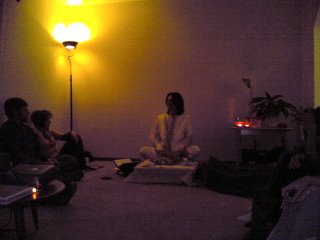The analogy we heard about contextualisation was to think of the message as the water of life in a container. The container it is presented in might be different depending on the culture. In the west, we are quite familiar with mugs with a round handle and an image printed on the side. In India, though, this would be very foreign. Contextualisation is the technique of using a vessel people are more familiar with so they can receive the drink.

The whole setup of the meeting was very different from anything I've ever seen before. We were still singing songs of worship to Jesus, though. We were simply using a style that Hindus would be very familiar with. This has been really successful in India where people have felt comfortable and familiar with the surroundings and able to receive the message and understand what is being said.
We had communion as part of the Puja. Instead of bread and red wine, we used bananas and milk. These are both things that are very abundant in India and easy for people to get. The milk can represent purity because it is white and the banana can represent Jesus body which was broken.
We also heard the gospel explained using a coconut as an illustration. As Dag, the leader, explained that Jesus was bruised and beaten for our sin, he hit the coconut with a hammer several times. Eventually, it cracked and the clear milk poured out of it, reminding me that when stabbed with the spear, water came out of Jesus' heart along with the blood. He talked about how we can now be as white as coconut because of this. To someone in India, a phrase like "as white as snow" would not make sense as most of them have not seen snow, yet everyone knows what coconuts are like.

Another interesting aspect was the use of incense. As we worshipped it was interesting to engage the sense of smell as well as sight and sound. It reminded me that Jesus can be like the air we breathe, able to expand and rise to places we couldn't reach.
We sang songs in Hindi with the English translation alongside it so we could see what we were singing. We sang about the name of Jesus, how it is a powerful, beautiful name and we sang about how he is our ultimate Guru and even that his word is our mantra. All the time, we were using terms people would be familiar with to help them understand our faith better.
The whole Puja experience gave me a bit of a feeling for how it must be for someone from a different culture to come to a "normal" church meeting in the west which is in a different language with all kinds of new things happening. At first I was constantly reading the English beside the Hindi to work out what I was actually saying. After we had repeated some of the songs a few times I started to remember and I was able to focus more on actually singing.
I've learned that there's no one structure or pattern that is correct for worship. In our western churches we are so stuck on the pattern of having a band playing worship songs and us all sitting in rows listening to someone at the front. These things are not bad, but they are not necessarily relevant to all cultures. It would be wrong to re-create the same thing elsewhere in the world and expect people to be familiar with it.
No comments:
Post a Comment